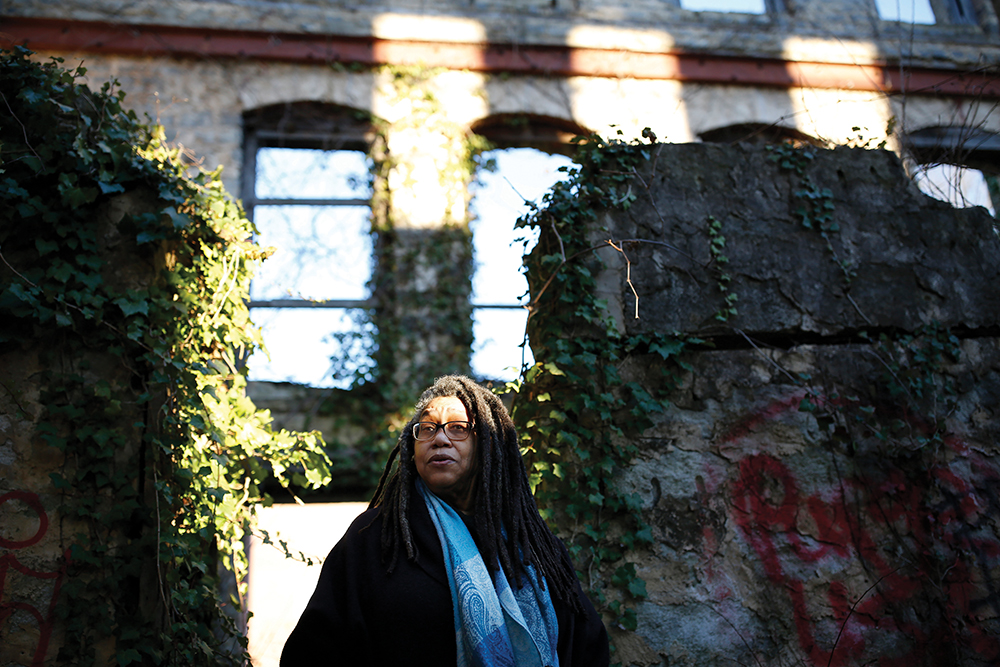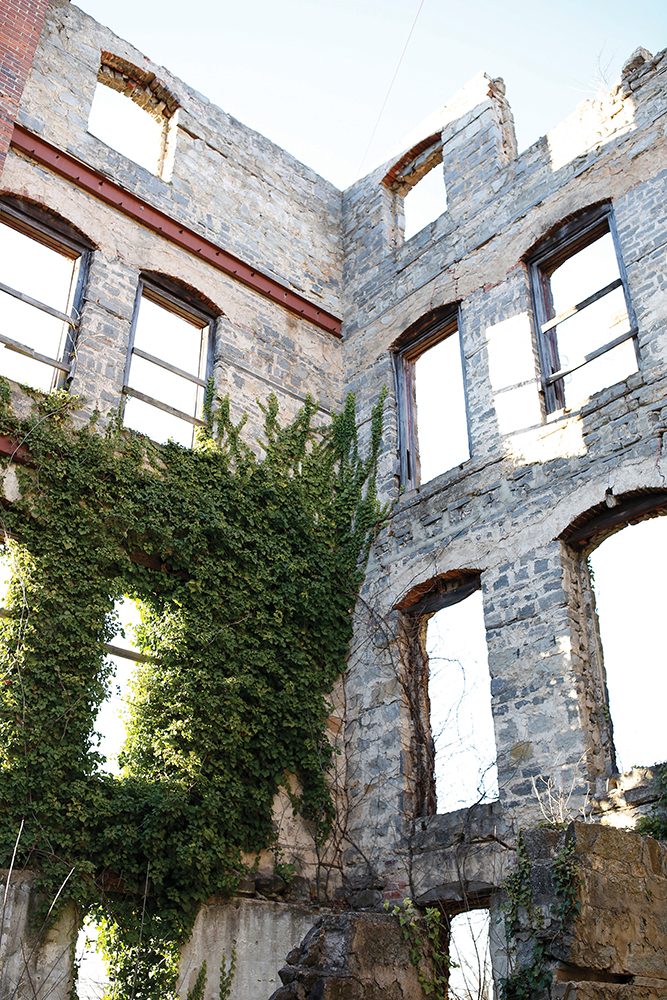For Saint Augustine’s professor Linda Dallas, it’s a mission to make art central to the conversation in Raleigh.
by Finn Cohen / photography by Eamon Queeney

At the corner of North State Street and Oakwood Avenue sit the skeletal remains of Saint Agnes Hospital, established in 1896 on the campus of Saint Augustine’s University. For years, it was the one of the only hospitals in the South for Black patients, and it closed after medical care became desegregated in the 1960s. Now it stands as a reminder of those days, and a marker of sorts between two Raleighs: the affluent enclave of Oakwood and the gentrifying neighborhoods just to the east.
For Linda Dallas, a professor of visual arts at Saint Augustine’s, the hospital is also a mission.
“I want it to connect and inform both of those communities,” says Dallas. She saw a lack of recognition of the site’s history, and started an arts collaboration project called Envision Saint Agnes Hospital as a way to honor the space. “That’s what artists do. They make places meaningful, even if there are not a lot of physical things there.”
For the last three years, Dallas has been spearheading the Envision Saint Agnes project — a slate of watercolor workshops, installations, walking tours, and pop-up painting and drawing events — with her students. And the city has responded, helping foster collaborations with local and international artists: in 2018, for example, Austrian duo OMAi worked with several local artists for a visual tribute to the boxer Jack Johnson, who was brought to Saint Agnes after a fatal car crash in 1946, that was projected onto the facade of the hospital.
“A Western model of art is the artist as the outsider, the renegade, the rebel,” Dallas adds. “But in many cultures, the artist is central to society and culture, and I think it’s time for the renegades and rebels to get engaged.”
Last fall, that engagement culminated in A Space for Reflection, an installation of murals by Black artists and artists of color on walls surrounding Saint Agnes and on the campus of Shaw University. The works, a collection of vivid expansions on last summer’s Black Lives Matter protests, had originally been painted on boarded-up businesses downtown after Raleigh’s own protests. Through a collaboration between the Black on Black Project, the Raleigh Murals Project, the Visual Art Exchange, and Raleigh Arts, they were able to become a physical part of the city’s HBCU campuses at the end of a tumultuous year.
“As an artist, advocate, and professor, Linda sees all angles of how things get done and gracefully shares that knowledge in the classroom and through partnerships,” says Michael Williams, founder of the Black on Black Project. “Without Linda Dallas, projects like this don’t happen.”

Fostering these types of cultural discussions informs Dallas’ work with students, whose own murals will be displayed on the fence surrounding Saint Agnes this fall. But she arrived at her current role through a long process of deeper connection with Raleigh itself. She moved to the city in 1985 to attend North Carolina State University’s College of Design, and over the past four decades, she’s become a vital part of Raleigh’s fabric of artists, serving on the city’s Arts Commission and becoming a member of the Public Art and Design Board.
Dallas grew up in Detroit, as part of a family where “everybody always had some kind of project, whether it was making puppets or reupholstering a couch.” She also had a mind that was drawn to systems: she majored in mathematics at Howard University, and spent part of her undergraduate time at Oak Ridge National Laboratory in Tennessee for a work-study program, collecting data for a fusion energy experiment. There wasn’t much to do socially in the town of Oak Ridge, so she took a few figure- drawing classes at the local art center. She loved it, and when an instructor there invited her to audit some of his similar classes at the University of Tennessee, a spark was lit.
Returning to Washington, Dallas felt an initial pull to go back to graduate school — she was accepted at Howard to study mathematics — but got a job working in the gift shop at the Hirshhorn Museum (then known as the Museum of African Art). That math program paled in comparison, she says: “I was at a museum, learning about African art, making money — it was fun!”
And it was at the Hirshorn gift shop that a chance conversation set Dallas on a new path. Chandra Cox, a professor at N.C. State’s College of Design, was browsing the store, and as the two spoke, they learned that both of their families were in Detroit, and that they’d even attended the same high school, years apart. Cox recommended that Dallas apply to the College of Design; she did, and soon she landed in Raleigh. Cox became her professor, then a friend — and even a patron of Dallas’ rich watercolor work.
“I own several Linda Dallases; I’m very proud of my collection, and intend to add to it,” says Cox, who says she’s seen Dallas blossom not only as a vital member of the Saint Augustine’s community, but also as an artist. “I’ve seen her work evolve, because when I met her, she was drawing primarily. Color theory is a big part of the education at College of Design, and I’m very proud of the contributions I’ve made to her development.”
After graduating, Dallas stuck around, working as a volunteer coordinator at the Children’s Museum About the World (which eventually became Exploris) and working her way up to director of exhibits. But her creative process stagnated, she says, for about a decade.
“Design school dumped so much information in my head, that it was just up there processing; it was there, but I couldn’t apply it,” she says. “One day, I just woke up and thought, ok, I can apply it.”
Dallas had studied industrial design at N.C. State, but she started exploring the potential for watercolor work on her own. Much of her work involves gardens and food, concepts that she finds to be rich ground for cultural understanding.
“I think that food — which is fuel for us, which is essential — has become such a commodity that there’s a disconnect from the process of how it goes from an animal or a plant to something on our plate,” she explains. “And cultures that would have their hands around each other’s throats in about 10 seconds if you sat them down at a table — they get along very well, cuisine-wise.”
Sarah Powers, the executive director for the Office of Raleigh Arts, has known Dallas for a decade, since they both worked on the city’s Arts Commission. The city’s recent collaborations with the Saint Agnes project, Powers says, have been a prime example of what Dallas brings to Raleigh. On one particular day, people who had been born at Saint Agnes were able to come to the site, have their portraits taken, and meet people who grew up in the neighborhood or who had just moved to Raleigh.
“It’s not like, Hey, this is what I personally want that’s the driving force behind her work,” Powers says. “It’s her collaborative spirit. She asks, how can we all come together and create a vision for the site? How can we use it now? How can we tell the story of this place?”
It’s a sense of place that really drives Dallas’ work. Teach- ing visual art remotely has been a challenge over the last year, Dallas says, but some of her most rewarding moments have come from seeing her students engaged with a space like the hospital that carries so much history.
“They have such pride that they can talk about this place, that other people are interested in their campus,” she says. “And I would say for 90% of the people who show up there, it is their first time on our campus — even though some of those people only live two or three blocks away.”
This article originally appeared in the March 2021 issue of WALTER magazine.
